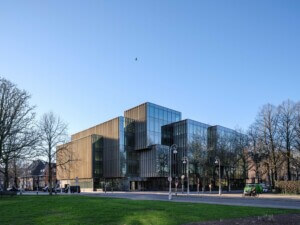Senior editor Matt Shaw sat down with Rotterdam- and New York–based ZUS (Zones Urbaines Sensibles) partners Elma van Boxel and Kristian Koreman to see what the United States can learn from the Netherlands, a country that is almost half below sea level and leads the way in water management in landscape
infrastructure design.
The Architect’s Newspaper: You have a host of urban and landscape projects that are currently in the works, some of which are very large in scale. Are any of these explicitly dealing with water?
ZUS: There are five water-related projects we are working on right now. The Almere Dune is an artificial dune landscape on the original polder (a piece of low-lying land reclaimed from the sea and protected by dikes), with 3,000 houses and a mixed-use core.
We are working on the world’s largest sea lock, at IJmuiden, which means we are doing the landscape design and architecture of three control centers. A similar project we are designing is the Hoogwatergeul Veessen, a three-mile river bypass that serves as a river flood basin, with a dynamic flood-protection bridge berm. There is also the self-initiated Delta 3000 project, which is a utopia that imagines the Netherlands as a dune metropolis. We are proposing massive dunes to counter soil inclination and rising waters.
Here in the U.S., we are working together with AECOM and ORG on the execution of our winning competition entry for Rebuild by Design: New Meadowlands. It is a very exciting combination of coastal protection, green infrastructure, and public amenities.
What are some of the issues that designers and researchers are dealing with in the Netherlands today? Is climate change an important topic for designers in the Netherlands?
Yes, of course many issues are climate related, like sea-level rise, rising temperatures, and new migration patterns. We also face a more diffuse clientele, as governments are retreating and new markets and players emerge. Therefore, designers have to be more proactive to get interesting commissions.
One of the main issues is water. As half of the country is below sea level, every project has to respond to the challenges of water coming in more intensely from all sides: Sea-level rise, river floods, rain events, and groundwater.
How do you see working in the U.S. as different from working in the Netherlands? What are the differences in attitude about water and dealing with climate change?
We face many of the same issues: Climate adaptation, bureaucracy, big companies versus small offices, less and less risk-taking. In the Netherlands, there’s a long tradition of spatial planning and the culture of design, where, for decades, they were by definition incorporated into policy making. In the last few years, a corporatism is emerging, where [experimentation] is hardly possible. The good news is that, in the U.S., we feel an emerging interest in design in all fields. However, there is still a big gap between the academic world and the real world there, including governments and bureaucracy.
What do you think other countries can learn from designers in the Netherlands, in terms of designing for water and with water?
We would say to them: Take sea-level rise really seriously, and do it together. Only if all parties—governments, designers, scientists, contractors, engineers—collaborate can the challenges be faced and countered. Build with nature, meaning that we will never win against the water unless we embrace its presence and dynamics. Introduce different levels of safety, and spread risks along hard infrastructure, adaptive landscapes, and evacuation programs.
Are attitudes to waterfront development changing in the Netherlands? How do is that possible? On-site infrastructure? Off-site?
After having the top-down Delta Works (1953) for many decades, protecting the Netherlands from 10,000-year storms, our country established a rich apparatus of water boards, such as the National WaterAuthority and local governmental agencies, to think of the next big threats. The first Delta Works turned the Netherlands into one big bathtub.
In addition to sea-level rise, extreme river floods and rain events are also severe risks to the country. Therefore, Room for the River was introduced, and the new Delta Works, which directs new policies for more local adaptations. For example, Almere Dune introduces a public–private partnership for making more resilient urban districts. This means that the dunes, privately funded, are contributing to national safety. And they are also a new way to live above sea level. The IJmuiden sea lock is made for the 200-year forecast of sea-level rise, so large-scale
infrastructure is made with great responsibility toward the future.
Off-site, we witness more adaptation measures, like water squares and retention basins to deal with extreme rain events. Nowadays, many of these projects come with multiple agendas with climate adaptation also taking a social responsibility.
This article was part of our Oct. 12 issue which focused on how water is shaping today’s landscape architecture and urbanism. Communities face deluges and droughts—for some, the stakes can be survival itself, but others see opportunities for decadence. To explore these stories from around the U.S. and the world, click here.










